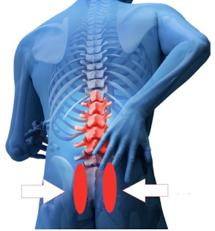 As you can imagine, much controversy surrounds manual testing for dysfunction of small joints that move as little as 2 mm. Many clinicians believe the following manual tests produce non reliable evidence of SI joint involvement in pain, but presently there are few other options.
As you can imagine, much controversy surrounds manual testing for dysfunction of small joints that move as little as 2 mm. Many clinicians believe the following manual tests produce non reliable evidence of SI joint involvement in pain, but presently there are few other options.
Medically, the customary procedure for SI joint diagnosis is joint blocks via injection, but these as well have difficulty standing up to criticisms. Clearly more research needs to be devoted to the accurate diagnosis of SI joint pain.
The above, however, does not necessarily mean these tests are not clinically useful. They can provide valuable information, particularly when they are able to reproduce symptoms, and of course be used to follow up and assess changes after therapeutic interventions. Since these tests are relatively safe and easy to perform, they can be used to gather clues.
The following tests are the most customary ones, and I will not delve into more complex testing in this post, as that is better suited to a clinician’s textbook.
Gaeslen’s Sign:
FABER Test:
ASIS Distraction:
Side-Lying Sacral Compression
Femoral Shear Test:
To Sum Up…
It is suggested by some therapists that at least 3 out of the 5 tests above must be positive to indicate SI joint involvement, and that if all 5 tests are negative, move on to testing other areas as possible pain generators. Physical therapist Stuart Fife, reports dismal numbers with regard to reliability and accuracy of manual testing methods, and Richard DonTigny asserts that often the correction validates the diagnosis.
Based on this information, it appears that all tests may give clues, and instead of any one given test, multiple tests should be performed to accurately test for SI joint involvement in pain, and which corrective measures should be carried out for resolution.
You might also be interested in these posts…
What Are The Sacroiliac Joints? How Do They Cause Pain?
How To Use An SI Joint Belt To Relieve Your Sacroiliac Joint Pain
